I am currently embroiled in a debate on when the Buff coat first appeared as armour. So as not to skew the replies with my personal research/opinion, I humbly ask for data on the appearance of the classical, butt stitched, buff coat prior to the start of the ECW....... tr
Good question, I'm curious too. I also want to know why it's called the "buff" coat exactly. One explanation I read claimed that it was short for "buffalo" and that they were made from buffalo leather. This doesn't make much sense to me. Where did they have buffalos in England?
| Adam D. Kent-Isaac wrote: |
| Good question, I'm curious too. I also want to know why it's called the "buff" coat exactly. One explanation I read claimed that it was short for "buffalo" and that they were made from buffalo leather. This doesn't make much sense to me. Where did they have buffalos in England? |
It's called a buff coat because of the color. It has nothing to do with buffaloes.
Buff is a pale yellow-brown colour that got its name from the colour of buff leather.
Paterson, Ian (2003), A Dictionary of Colour (1st paperback ed.), London: Thorogood (published 2004), p. 73, ISBN 1854183753, OCLC 60411025
See also: Buff (colour)
Buff Leather is "a strong supple oil-tanned leather produced chiefly from cattle hides"
Merriam-Webster Dictionary
But that still doesn't explain why buff leather is called buff leather. this site claims it originated with the word buffalo. "a soft, thick, light-yellow leather with a napped surface, originally made from buffalo skin but later also from other skins, used for making belts, pouches, etc."
The Osprey book on English Civil War cavalry that I just got today suggests that the buff coat is a descendant of the arming doublet, and that "contemporary pictures of European soldiers show sleeveless buff coats cut short, which are worn only as padding under armour, and this idea was also adapted by having leather linings fixed into individual pieces of armour."
This painting of counts of Nassau would seem to square with that description. In this case, it shows Heinrich von Nassau-Dillenburg equipped as a cuirassier of the time, with his cuirass off and buff leather underneath. Notice the tied-on sleeve:
[ Linked Image ]
Quite different indeed from the thigh-length, sleeved buff coats worn underneath a cuirass by English Civil War arquebusiers.
The Osprey book on English Civil War cavalry that I just got today suggests that the buff coat is a descendant of the arming doublet, and that "contemporary pictures of European soldiers show sleeveless buff coats cut short, which are worn only as padding under armour, and this idea was also adapted by having leather linings fixed into individual pieces of armour."
This painting of counts of Nassau would seem to square with that description. In this case, it shows Heinrich von Nassau-Dillenburg equipped as a cuirassier of the time, with his cuirass off and buff leather underneath. Notice the tied-on sleeve:
[ Linked Image ]
Quite different indeed from the thigh-length, sleeved buff coats worn underneath a cuirass by English Civil War arquebusiers.
| Adam D. Kent-Isaac wrote: |
| But that still doesn't explain why buff leather is called buff leather. |
My post does say, "Buff leather is a strong supple oil-tanned leather produced chiefly from cattle hides". Leather for cows is buff color, as are many oxen leather and some other cow-like animals (water buffalo, etc.). American buffalo (bison) hides are varied in color but overall are about the same as a cow.
| Quote: |
| Buffalo derives from the Portoguese bufalo, which in turn came from the Latin bufalus, a variant of bubalus (wild ox), which is merely a transliteration of the Greek boubalos (buffalo; βούβαλος), from bous (ox, cow; βους)
In modern Greek a) bubalos (or vuvalos or vuvali): buffalo [βούβαλος] b) bubala (or vuvala): female buffalo [βουβάλα] |
Hello,
I'm not sure about Buff leather coming from Buffalo but there are both buffalo and wisent (European Bison) living in Europe. I'll be very interested to see if anyone knows when this form of armour came into use. The examples I have seen in museums have been very impressive.
I'm not sure about Buff leather coming from Buffalo but there are both buffalo and wisent (European Bison) living in Europe. I'll be very interested to see if anyone knows when this form of armour came into use. The examples I have seen in museums have been very impressive.
I have no idea where it first came into being. Well into the 16th they seem to have various types of under armours in use but
I do not recall finding buff coats in use by mid 16th. That said I slow down a great deal on the amount of primary material I have read after 1558 or so.
I do know I have seen original buff coats with sleeves of both leather and padded ones. The RA has some very nice ones up on display last I was there.
RPM
I do not recall finding buff coats in use by mid 16th. That said I slow down a great deal on the amount of primary material I have read after 1558 or so.
I do know I have seen original buff coats with sleeves of both leather and padded ones. The RA has some very nice ones up on display last I was there.
RPM
Buffcoats begin to appear in the the Dutch artwork in the first decade after 1600, below is a selection of paintings from the 1600-1615 period, those of named events such as the battle of Nieuport or Siege of Ostend were made later, probably in the 1610-15 period or a few years earlier. In addition we see buff coats being mentioned in military texts at this time. Spanish & Imperial General Giorgio Basta wrote about the need for swords to be properly shaped so that a thrust would penetrate the "Coats" (Collete) and "Buffels" worn by cavalrymen. (Il governo della cavalleria leggera published in 1612 but written before his death in 1607)

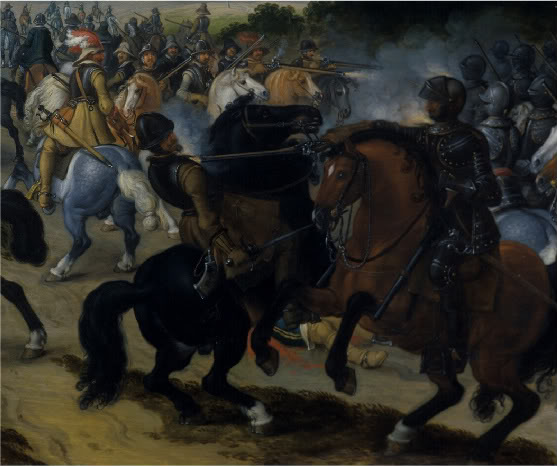
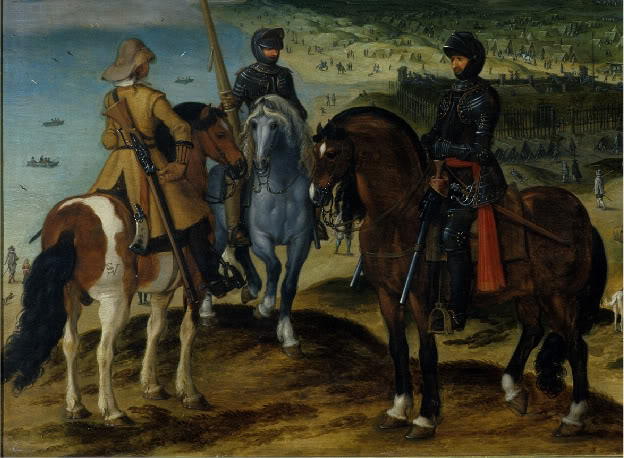


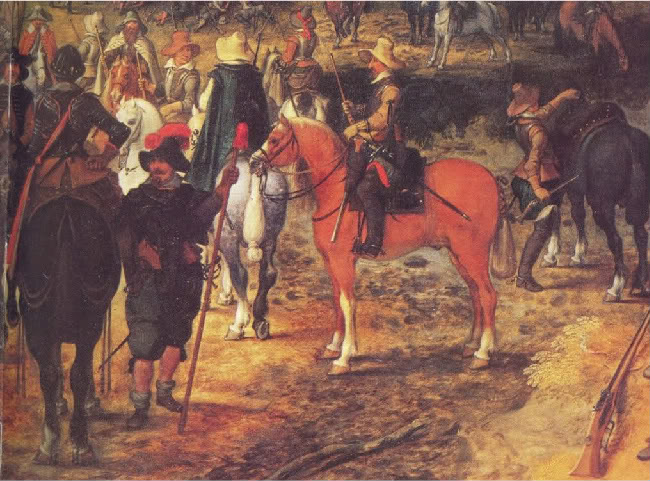
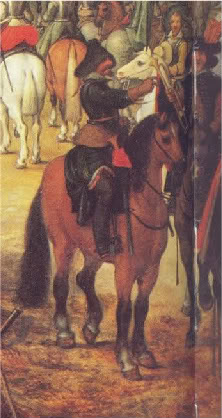
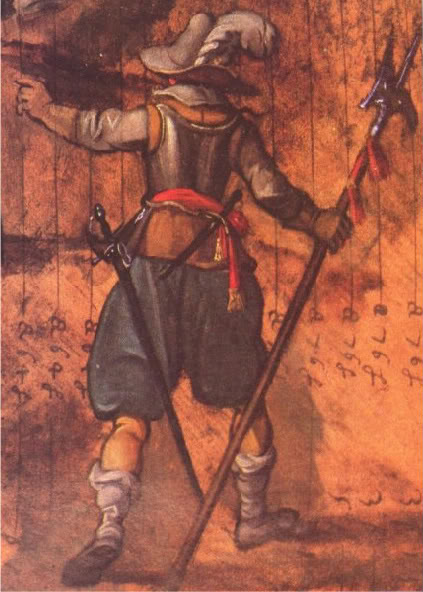








Buff coats are a swine to make if you're not a skilled leatherworker. Most of the replicas on the market are too thin, not butt stitched and made of poor leather. A couple of years ago I bought some leather from Clayton's in Chesterfield England and made a fair attempt (pictured). If you can afford one then Karl Robinson makes superb copies. Love the Netherlands artwork Daniel, great to see the progression from Dutch to the Swedish and English cavalry of the TYW and ECW - whenever I enter trettioarigakriget into google I come up with a few nice varjor but mainly sites devoted to an obscure 70s rrock outfit! Any hints?
Stephen Wheatley
Stephen Wheatley
Pictures as promised. My long-suffering chum Amy looking Gustavian in buff and wielding a hanger!
 Attachment: 144.5 KB
Attachment: 144.5 KB

 Attachment: 163.42 KB
Attachment: 163.42 KB
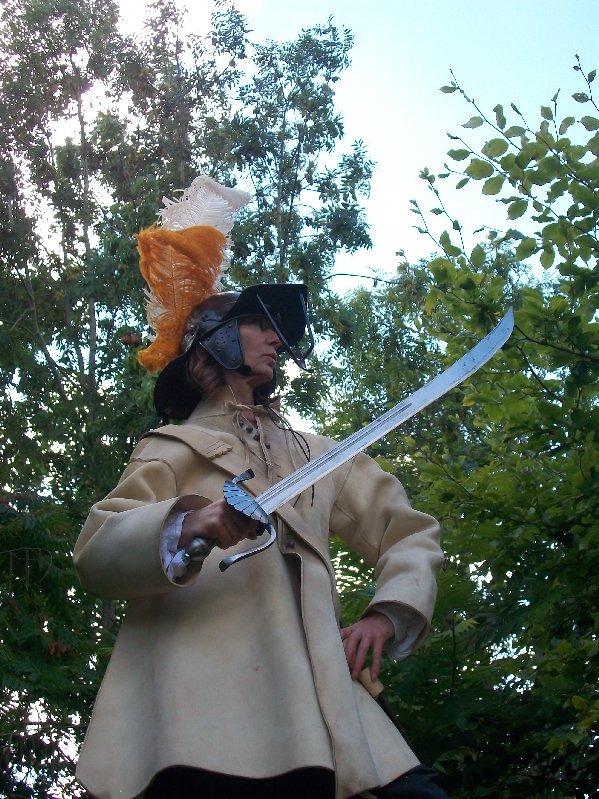
 Attachment: 133.58 KB
Attachment: 133.58 KB

 Attachment: 78.46 KB
Attachment: 78.46 KB
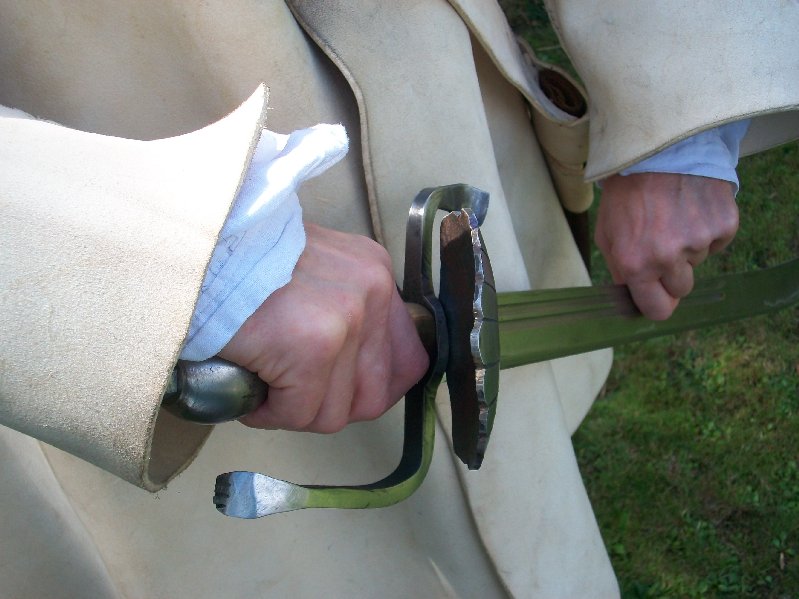




there seems to have been a general surge in the use of leather around 1600, not only for buffcoats but also for boots, wide belts, and so on.
This could posibly be linked to an increase in cattle ranching. The buff coat was still a very expensive item. In the sumary of the costs of the New Model Army-troopers equipment, the buff coat is the most expensive item.
This could posibly be linked to an increase in cattle ranching. The buff coat was still a very expensive item. In the sumary of the costs of the New Model Army-troopers equipment, the buff coat is the most expensive item.
Hi,
it must be Asian water-buffalo leather: see what they say in Wikipedia :
"Introduced into North Africa and the Near East by 600 AD, the water buffalo was brought to Europe with returning Crusaders in the Middle Ages,[citation needed] and herds can be found in Turkey, Bulgaria, Romania, Albania, Hungary, Austria and Italy. [...]. Buffalo milk is used for the production of buffalo mozzarella in Campania and many other locations around the world."
it must be Asian water-buffalo leather: see what they say in Wikipedia :
"Introduced into North Africa and the Near East by 600 AD, the water buffalo was brought to Europe with returning Crusaders in the Middle Ages,[citation needed] and herds can be found in Turkey, Bulgaria, Romania, Albania, Hungary, Austria and Italy. [...]. Buffalo milk is used for the production of buffalo mozzarella in Campania and many other locations around the world."
Good leather is still quite expensive nowadays, and hard to work.
When I bought my leather jacket I wanted it in a heavier quality, one I had seen and felt.
The tailor refused, the jacket I was talking about was an one-off as his seamstresses
had been complaining quite loud.
When I bought my leather jacket I wanted it in a heavier quality, one I had seen and felt.
The tailor refused, the jacket I was talking about was an one-off as his seamstresses
had been complaining quite loud.
Daniel thank you! that is exactly the kind of reference I am looking for .... ( the Giorgio Basta reference). Especially nice to have non Anglo-centric information on the appearance of the buff coat. David Edge supposedly has this mythical inventory reference with a buff coat dating to the 1590s, however no one seems to know the actual reference that is being referred to. 1607 is actually earlier than the earliest English reference I currently have (1612) that specifically mentions "buff cote" so AFAIK that General Basta reference sets the bar for now. thanks again, and please keep the early pictorial and written evidence on the first appearance of the buff coat coming. TR
edit: yes I am aware that the remnants of a leather jerkin was found with the Mary Rose (sank in 1545). And there are several other references for leather and linen jerkins in the second half of the 16th c. These were sleeveless, often slashed and cut in decorative patterns to show the linen liner underneath. But they were not made specifically to be armour, nor were they made of the same grade of heavy leather as the buff. nor were they stitched or finished like the buff
edit: yes I am aware that the remnants of a leather jerkin was found with the Mary Rose (sank in 1545). And there are several other references for leather and linen jerkins in the second half of the 16th c. These were sleeveless, often slashed and cut in decorative patterns to show the linen liner underneath. But they were not made specifically to be armour, nor were they made of the same grade of heavy leather as the buff. nor were they stitched or finished like the buff
| Adam D. Kent-Isaac wrote: |
| But that still doesn't explain why buff leather is called buff leather. this site claims it originated with the word buffalo. "a soft, thick, light-yellow leather with a napped surface, originally made from buffalo skin but later also from other skins, used for making belts, pouches, etc."
The Osprey book on English Civil War cavalry that I just got today suggests that the buff coat is a descendant of the arming doublet, and that "contemporary pictures of European soldiers show sleeveless buff coats cut short, which are worn only as padding under armour, and this idea was also adapted by having leather linings fixed into individual pieces of armour." This painting of counts of Nassau would seem to square with that description. In this case, it shows Heinrich von Nassau-Dillenburg equipped as a cuirassier of the time, with his cuirass off and buff leather underneath. Notice the tied-on sleeve: [ Linked Image ] Quite different indeed from the thigh-length, sleeved buff coats worn underneath a cuirass by English Civil War arquebusiers. |
It's like a buff vest!
That's an interesting assortment of armour, the Maxamillian harness must have been old when this painting was made.
Hi,
the British are very conservative: they still wore it during the two World Wars :D
http://sites.google.com/site/themanchesters19...her-jerkin
the British are very conservative: they still wore it during the two World Wars :D
http://sites.google.com/site/themanchesters19...her-jerkin
There's an interesting mention inThe Manuscripts of the Right HonourableF. J. Savile Foljambe of Osberton (HMC 15th Report, Appendix, Part V 1897) from 1588 detailing the various abuses committed by some of the captains on their men and the equipment loses reported. Amongest the Corsletts, Coats of plates, Alman Rivet , headpieces amd morrions lost is a single reference to a "Bufierkin" It's the only reference found ever. It's thought to be a Buff jerkin but no one is sure. It's not a piece of a soldiers private clothing as the only equipment reported on is that paid for by the Counties to equipe their men.
The 1625 Virginia Muster lists buff coats among the armor present.
http://www.virtualjamestown.org/Muster/arms24.html
http://www.virtualjamestown.org/Muster/arms24.html
I know this topic is a bit old but still of interest to me. I found a reference dating 1562 reportedly from Mary Queen of Scotts, see below in reference to Marys words.
"In 1562 the English ambassador reported to Elizabeth, 'When the soldiers came back from the night's sentry-duty, she said she was sorry she was not a man to be all night on the fields and to walk the causeway with buff-coat, steel-helmet, buckler, and broadsword.'
"In 1562 the English ambassador reported to Elizabeth, 'When the soldiers came back from the night's sentry-duty, she said she was sorry she was not a man to be all night on the fields and to walk the causeway with buff-coat, steel-helmet, buckler, and broadsword.'
Thought that this photo may add to the conversation somewhat.

Taken from page 69 of "Arms and Armour" by Vesey Norman

Taken from page 69 of "Arms and Armour" by Vesey Norman
Page 1 of 1
You cannot post new topics in this forumYou cannot reply to topics in this forum
You cannot edit your posts in this forum
You cannot delete your posts in this forum
You cannot vote in polls in this forum
You cannot attach files in this forum
You can download files in this forum
All contents © Copyright 2003-2006 myArmoury.com — All rights reserved
Discussion forums powered by phpBB © The phpBB Group
Switch to the Full-featured Version of the forum
Discussion forums powered by phpBB © The phpBB Group
Switch to the Full-featured Version of the forum